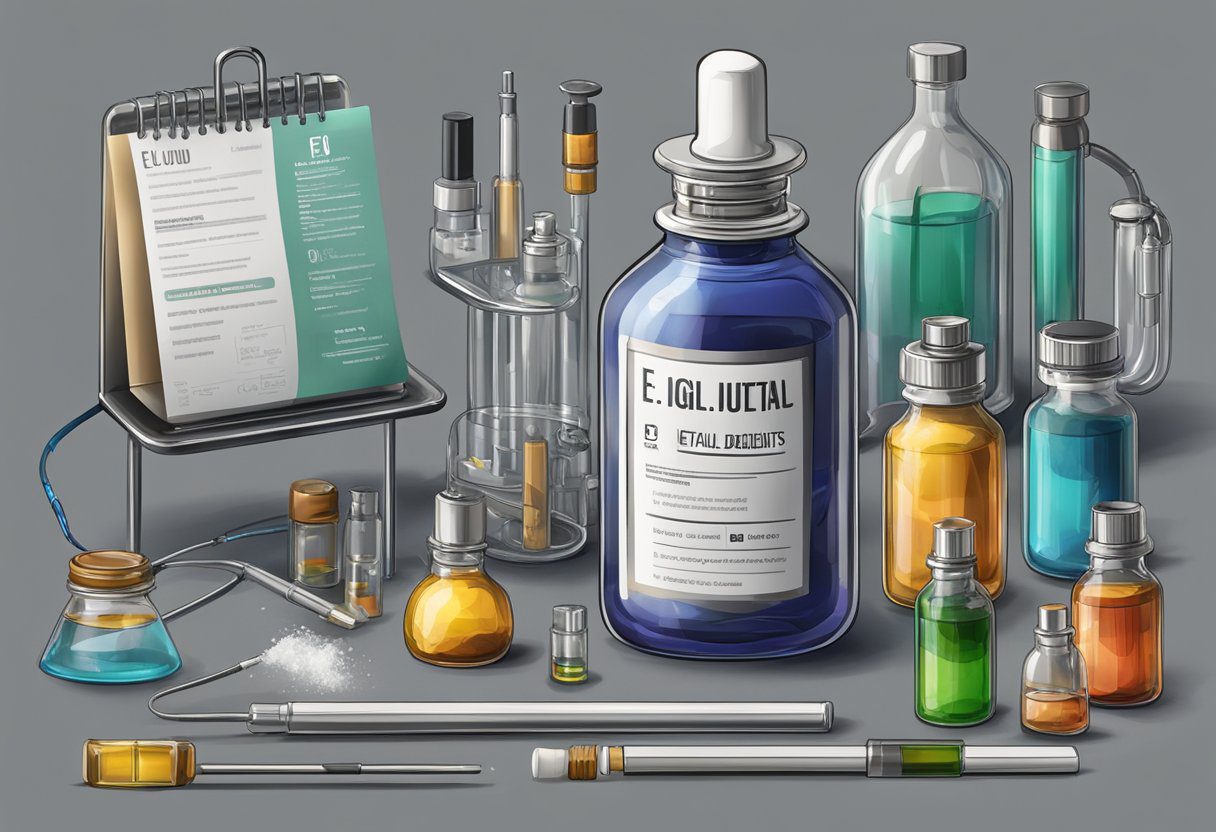Does E-Liquid Contain Heavy Metals? Exploring the Facts
E-liquids have been a popular alternative to traditional cigarettes, with many people turning to vaping as a way to quit smoking. However, concerns have been raised about the safety of e-liquids and whether they contain heavy metals. Heavy metals are toxic and can cause a range of health problems, including cancer and damage to the nervous system.
Regulatory bodies and health experts have been keeping a close eye on the issue of heavy metals in e-liquids. While there is no clear evidence that e-liquids contain high levels of heavy metals, some studies have found that some e-liquids do contain traces of heavy metals. This has led to calls for tighter regulation of the e-liquid industry to ensure that consumers are not exposed to harmful substances.
Contents
Key Takeaways
- Heavy metals can be toxic and pose a health risk.
- While there is no clear evidence that e-liquids contain high levels of heavy metals, some studies have found traces of heavy metals in some e-liquids.
- Regulatory bodies and health experts are calling for tighter regulation of the e-liquid industry to ensure consumer safety.
Regulatory Landscape
EU and UK Legislation
The regulatory landscape for e-cigarettes in the UK and the EU is governed by the Tobacco Products Directive (TPD). The TPD sets out the rules governing the manufacture, presentation, and sale of e-cigarettes and e-liquids. These rules include restrictions on the nicotine content of e-liquids, liquid, and the labeling of products. The TPD also sets limits on the levels of heavy metals such as cadmium, chromium, lead, and mercury in e-cigarettes and e-liquids.
In the UK, the Medicines and Healthcare products Regulatory Agency (MHRA) is responsible for enforcing the TPD regulations. Manufacturers and importers of e-cigarettes and e-liquids must comply with the regulations set out by the MHRA. Failure to comply can result in enforcement action, including fines and product recalls.
MHRA and TPD Compliance
To comply with the TPD regulations, e-cigarette and e-liquid manufacturers must ensure that their products do not contain levels of heavy metals that exceed the limits set out by the TPD. This can be achieved by using high-quality ingredients and ensuring that manufacturing processes are carried out to a high standard.
Manufacturers must also ensure that their products are properly labeled and that they meet the requirements for packaging and refill containers. This includes ensuring that the nicotine content of e-liquids is clearly indicated on the packaging and that the containers are child-resistant.
In conclusion, the regulatory landscape for e-cigarettes and e-liquids in the UK and the EU is governed by the TPD, which sets out the rules for the manufacture, presentation, and sale of these products. Compliance with the regulations is enforced by the MHRA, and manufacturers must ensure that their products do not contain levels of heavy metals that exceed the limits set out by the TPD. By complying with these regulations, manufacturers can ensure that their products are safe and of high quality, which is essential for the health and well-being of vapers.
Components and Materials
When discussing e-liquids, it is essential to understand the components and materials that make them up. E-liquids are a combination of propylene glycol, glycerin, nicotine, and flavourings. The heating coils and batteries used in e-cigarettes can also play a role in the presence of heavy metals.
E-Liquid Ingredients
Propylene glycol and glycerin are the two main ingredients in e-liquids. These substances are responsible for creating the vapour that users inhale. Both propylene glycol and glycerin are generally recognised as safe by the Food and Drug Administration (FDA) and European Food Safety Authority (EFSA).
Nicotine is also present in e-liquids, although not all e-liquids contain nicotine. Nicotine is an addictive substance and can be harmful in high concentrations. Users should always be aware of the nicotine concentration in their e-liquid and use it responsibly.
Flavourings are added to e-liquids to give them a unique taste. These flavourings can be natural or artificial and are typically food-grade.
Vape Coils and Batteries
The coils and batteries used in e-cigarettes can also play a role in the presence of heavy metals. The coils are typically made of metal, and when heated, they can release small amounts of metal particles into the vapour. These metals can include nickel, chromium, and lead.
Batteries used in e-cigarettes can also contain heavy metals such as cadmium and lead. However, the concentration of these metals is relatively low and is not a significant cause for concern.
It is important to note that the levels of heavy metals found in e-cigarettes are generally much lower than those found in traditional cigarettes. Vaping is a safer alternative to smoking, and e-liquids should be used responsibly.
Health Implications
Vaping has become an increasingly popular alternative to smoking cigarettes. However, concerns have been raised about the potential health risks associated with e-liquid, particularly with regards to toxic metal exposure.
Toxic Metal Exposure
Studies have shown that e-cigarettes can expose users to toxic metals such as arsenic, lead, and silicate particles 1. These metals can be found in the vape coils and other components of e-cigarettes. While the levels of exposure are generally lower than those associated with smoking traditional cigarettes, the long-term effects of exposure to these metals are not yet fully understood.
Testing and Analysis
Heavy Metals Testing
One of the concerns with e-liquids is the potential presence of heavy metals, which can be harmful to health. To ensure the safety of e-liquids, manufacturers must conduct heavy metals testing. This testing involves the detection and quantification of various heavy metals, such as lead, cadmium, and mercury, that may be present in e-liquids.
ICP-OES (Inductively Coupled Plasma Optical Emission Spectroscopy) is a common method used for heavy metals testing in e-liquids. This method is sensitive and can detect heavy metals at very low concentrations. A recent study conducted by researchers at the Hopkins Bloomberg School of Public Health revealed that the liquids in several popular brands of e-liquids contain some amounts of toxic metals that are potentially harmful to health. Although scientists still question the actual dangerousness of the quantities of metals identified, there is still a risk that these substances will pass into the body through vaping.
Emissions and Aerosol Analysis
In addition to heavy metals testing, emissions and aerosol analysis is also important in ensuring the safety of e-liquids. This testing involves the analysis of the vapour coming from the vaporisation of e-liquids to ensure that the metal parts of the e-cigarette are not contaminated.
Based on compliance with the French standard AFNOR XP D90-300 part 3 on emission analysis, ingésciences analyses the vapour coming from the vaporisation of e-liquids to ensure that the metal parts of the e-cigarette are not contaminated. Liquid nicotine concentration analysis is also used to compile the relevant dose (nicotine dose uptake) required in the notification stage and provides a valuable reference to verify the quality of production through an external supplier.
Overall, heavy metals testing and emissions and aerosol analysis are crucial in ensuring the safety of e-liquids. Manufacturers must conduct these tests to ensure that their products are free from metal contamination and safe for consumers to use.
Consumer Awareness
As with any consumer product, it is important for vapers to be aware of the potential health risks associated with vaping. While vaping is generally considered to be a safer alternative to smoking, it is important to note that e-liquids may contain heavy metals such as lead, arsenic, and cadmium.
Consumers should be aware of the potential risks associated with exposure to heavy metals, as they can have serious health implications. For example, exposure to lead can cause neurological damage, while exposure to arsenic can increase the risk of cancer.
To mitigate these risks, it is important for vapers to choose high-quality e-liquids that have been tested for heavy metals. Additionally, consumers should look for products that are clearly labelled with information about their ingredients and potential health risks.
It is also important for regulatory authorities to take action to ensure that e-liquids are safe for consumers. This may include requiring manufacturers to test their products for heavy metals and other potentially harmful substances, as well as implementing product labelling requirements to ensure that consumers are fully informed about the risks associated with vaping.
Overall, while vaping can be a safer alternative to smoking, it is important for consumers to be aware of the potential risks associated with heavy metal exposure. By choosing high-quality e-liquids and staying informed about potential health risks, consumers can minimise their risk of harm.
Frequently Asked Questions:
Are heavy metals a significant concern in e-liquids available in the EU and UK?
How do regulations in the EU and UK ensure the safety of e-liquids?
Can I trust the quality of e-liquids I purchase in the EU and UK?
What steps do manufacturers take to prevent heavy metal contamination in e-liquids?
Is vaping a safer alternative to smoking in terms of heavy metal exposure?







Leave a Reply